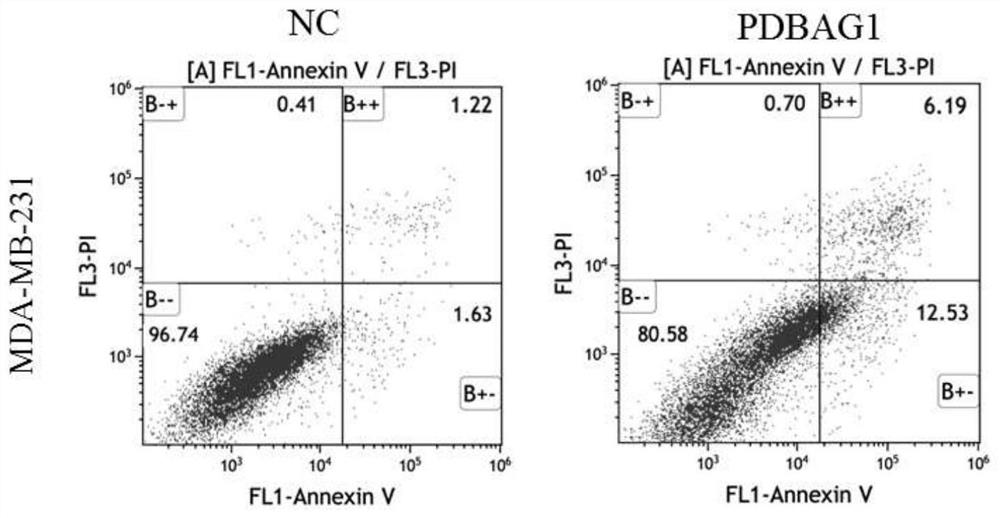Polypeptide derived from mammary gland adipose tissue and anti-tumor application thereof
An adipose tissue-derived technology, applied in the field of anti-tumor, can solve the problem of lack of available therapeutic targets for triple-negative breast cancer
- Summary
- Abstract
- Description
- Claims
- Application Information
AI Technical Summary
Problems solved by technology
Method used
Image
Examples
Embodiment 1
[0023] Example 1 Polypeptide PDBAG1-unmodified and PDBAG1 synthesis and analysis of biological parameters
[0024] The sequence of the polypeptide PDBAG1-unmodified is Ala Ser Lys Lys Val Cys Ile Val Gly SerGly Asn Trp Gly Ser Ala Ile Ala (SEQ ID NO.1), which is a polypeptide molecule composed of 18 amino acids, which naturally has acetylation at the N-terminus grooming. The main biological parameters of the peptide obtained through the online peptide analysis tool are as follows: the isoelectric point (Theoretical pI) is 9.32, and the molecular weight (Molecular weight, Mw) is 1748.03. Entrust Shanghai Keyeptide Biotechnology Co., Ltd. to synthesize the polypeptide with the sequence shown above by solid-phase method.
[0025] In order to optimize the performance of the polypeptide molecule and make it better enter the cell to function, we added a membrane-penetrating peptide fragment at its N-terminus: GRKKRRQRRRPPQQ, and modified the polypeptide sequence to: Gly Arg Lys Lys...
Embodiment 2
[0027] Example 2 Effects of Polypeptide PDBAG1 on the Viability of Triple Negative Breast Cancer Cells
[0028] The triple-negative breast cancer cell MDA-MB-231 was subjected to standard conditions (37°C, 5% CO 2 )nourish. On the first day, inoculate in a 96-well culture plate at a density of 2000 cells / 100ul medium / well; on the second day, treat with polypeptide PDBAG1-unmodified and PDBAG1 (set 10, 50μM high and low concentrations), control The group was treated with ultrapure water; after 24h, 48h, and 72h of polypeptide treatment, the medium containing 10% CCK-8 reagent was prepared respectively, the medium was replaced, and the culture was continued for 1h under standard conditions, and the absorbance value at 450nm wavelength was detected by a microplate reader , the growth curves are depicted in terms of OD values.
[0029] The result is as figure 1 As shown in A and B, the polypeptide PDBAG1-unmodified at a concentration of 50 μM can significantly inhibit the viabi...
Embodiment 3
[0030] Example 3 Distribution of FITC-labeled polypeptide PDBAG1 in cells
[0031] The triple-negative breast cancer cell MDA-MB-231 was subjected to standard conditions (37°C, 5% CO 2 )nourish. On the first day, they were seeded in 6-well culture plates at a density of 200,000 cells / 2ml medium / well; on the second day, the experimental group was treated with FITC fluorescently labeled PDBAG1 at a concentration of 30 μM, and the control group was treated with ultrapure water; After the polypeptide was treated for 24 hours, the cell entry of the polypeptide was observed using a fluorescence microscope.
[0032] The result is as figure 2 As shown, the polypeptide PDBAG1 can enter into triple-negative breast cancer cells, and is distributed in both the nucleus and cytoplasm, suggesting the possible mechanism of its function.
PUM
 Login to View More
Login to View More Abstract
Description
Claims
Application Information
 Login to View More
Login to View More - R&D
- Intellectual Property
- Life Sciences
- Materials
- Tech Scout
- Unparalleled Data Quality
- Higher Quality Content
- 60% Fewer Hallucinations
Browse by: Latest US Patents, China's latest patents, Technical Efficacy Thesaurus, Application Domain, Technology Topic, Popular Technical Reports.
© 2025 PatSnap. All rights reserved.Legal|Privacy policy|Modern Slavery Act Transparency Statement|Sitemap|About US| Contact US: help@patsnap.com



